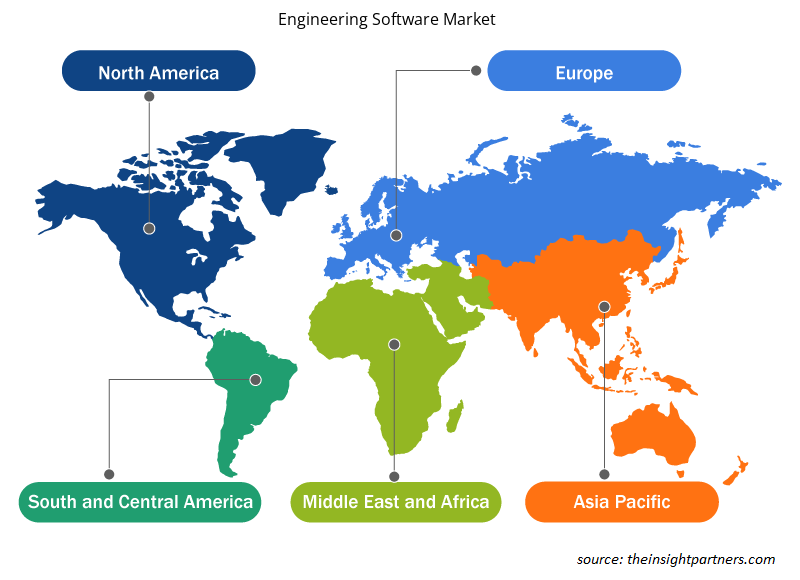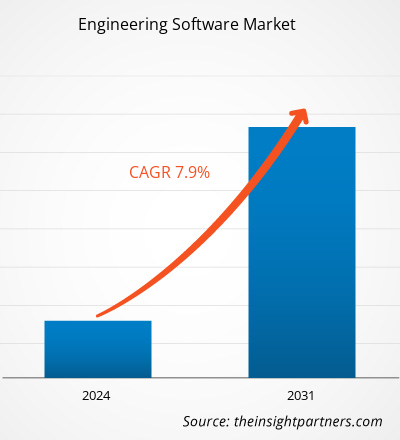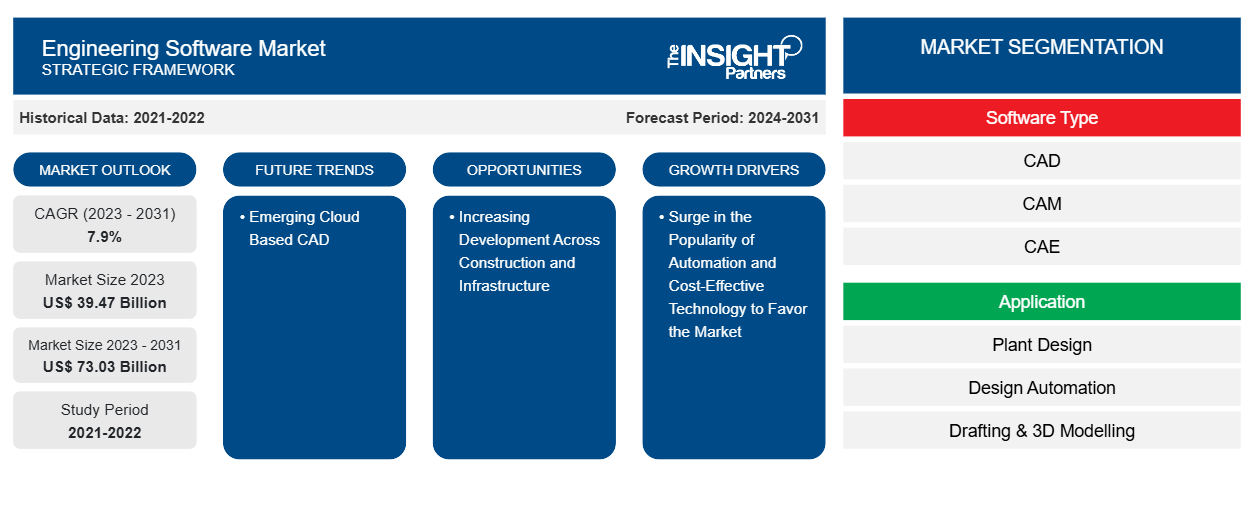工程软件市场规模预计将从 2023 年的 394.7 亿美元增至 2031 年的 730.3 亿美元。预计 2023-2031 年市场复合年增长率将达到 7.9%。自动化和高性价比技术的普及可能仍是工程软件市场的主要趋势。
工程软件市场分析
汽车、航空航天、建筑和医疗保健等各行各业对 CAD 和 CAE 软件的使用日益增多,推动了市场扩张。工程软件包括计算机辅助设计 (CAD)、计算机辅助制造 (CAM) 和计算机辅助工程 (CAE) 等。预计工程软件市场将在整个预测期内大幅扩张,原因多种多样,包括企业对缩短产品开发时间和费用的需求不断增加。
工程软件市场概览
工程师、设计师和制造商可以借助工程软件解决方案编写关键工程文档、分析和模拟产品性能和操作,以及开发复杂模型。借助基于云的解决方案,团队成员可以使用他们选择的任何设备进行远程协作,因为他们可以通过 Web 浏览器访问。因此,企业可以在不牺牲计算能力或实用性的情况下实现现代化并减少硬件支出。
定制此报告以满足您的需求
您可以免费定制任何报告,包括本报告的部分内容、国家级分析、Excel 数据包,以及为初创企业和大学提供优惠和折扣
-
获取此报告的关键市场趋势。这个免费样品将包括数据分析,从市场趋势到估计和预测。
工程软件市场驱动因素和机遇
自动化及高性价比技术普及度激增,利好市场。
由于市场竞争日益激烈,全球工厂 0/0 和 EPC 面临着减少生产错误和运营费用的压力。工厂工程师可以在设计、生产和调试过程中遵循特定的国际标准来提高质量。生产和强度问题可以通过设计软件、持续分析和标准升级来解决。因此,世界各地的企业越来越多地使用工程软件来减少建筑和生产中的错误。
加快建筑和基础设施建设发展
建筑业被认为是任何国家社会经济发展的主要因素之一。建筑业正在埃塞俄比亚、印度、中国、巴西、乌兹别克斯坦、柬埔寨、坦桑尼亚和缅甸等世界各地的发展中国家迅速扩张。这些经济体的基础设施也在快速发展。例如,亚太地区和南半球的发展中经济体正在吸引大量外国直接投资用于基础设施建设。这些进步也将刺激其基础设施的增长,随着建筑业的扩张,对工程软件的需求也将随之增长。因此,预计基础设施和建筑业务垂直领域的不断进步将带来更多收益。
工程软件市场报告细分分析
有助于得出工程软件市场分析的关键部分是软件类型和应用。
- 根据软件类型,工程软件市场分为 CAD、CAM、CAE、AEC 和 EDA。预计 CAD 部分将在预测期内增长。
- 根据应用,市场分为工厂设计、设计自动化、绘图和 3D 建模、产品设计和测试等。预计设计自动化领域在预测期内将实现增长。
工程软件市场份额按地区分析
工程软件市场报告的地理范围主要分为五个区域:北美、亚太地区、欧洲、中东和非洲以及南美/南美和中美。北美主导了工程软件市场。北美地区各行业的高科技采用趋势推动了工程软件市场的增长。数字工具的采用率提高和政府机构的高技术支出等因素预计将推动北美工程软件市场的增长。此外,美国和加拿大等发达经济体高度重视研发,这迫使北美参与者将技术先进的解决方案推向市场。此外,美国拥有大量工程软件市场参与者,他们越来越注重开发创新解决方案。所有这些因素都促进了该地区工程软件市场的增长。
工程软件市场区域洞察
Insight Partners 的分析师已详细解释了预测期内影响工程软件市场的区域趋势和因素。本节还讨论了北美、欧洲、亚太地区、中东和非洲以及南美和中美洲的工程软件市场细分和地理位置。

- 获取工程软件市场的区域特定数据
工程软件市场报告范围
| 报告属性 | 细节 |
|---|---|
| 2023 年的市场规模 | 394.7亿美元 |
| 2031 年市场规模 | 730.3亿美元 |
| 全球复合年增长率(2023 - 2031) | 7.9% |
| 史料 | 2021-2022 |
| 预测期 | 2024-2031 |
| 涵盖的领域 |
按软件类型
|
| 覆盖地区和国家 |
北美
|
| 市场领导者和主要公司简介 |
|
工程软件市场参与者密度:了解其对业务动态的影响
工程软件市场正在快速增长,这得益于最终用户需求的不断增长,而这些需求又源于消费者偏好的不断变化、技术进步以及对产品优势的认识不断提高等因素。随着需求的增加,企业正在扩大其产品范围,进行创新以满足消费者的需求,并利用新兴趋势,从而进一步推动市场增长。
市场参与者密度是指在特定市场或行业内运营的企业或公司的分布情况。它表明在给定市场空间中,相对于其规模或总市场价值,有多少竞争对手(市场参与者)存在。
在工程软件市场运营的主要公司有:
- PTC
- 罗克韦尔自动化公司
- 思爱普
- 西门子
- Synopsys 公司
- 欧特克公司
免责声明:上面列出的公司没有按照任何特定顺序排列。

- 获取工程软件市场顶级关键参与者概览
工程软件市场新闻和最新发展
工程软件市场通过收集一手和二手研究后的定性和定量数据进行评估,其中包括重要的公司出版物、协会数据和数据库。以下是市场发展情况的列表:
- 2024 年 2 月 - 全球科技公司 Cognizant 旨在通过扩展其平台产品系列来加速业务现代化。该公司宣布推出 Cognizant Flowsource,这是一个支持 AI 的生成式平台,旨在为软件工程的新时代提供动力。
(来源:Cognizant,新闻稿,2024 年)
- 2023 年 6 月,Nullspace, Inc. 作为 IERUS Technologies 的子公司成立,IERUS Technologies 是阿拉巴马州亨茨维尔的一家知名国防承包商。Nullspace, Inc. 专注于为电磁应用提供先进的工程软件。
(来源:Nullspace,新闻稿,2023 年)
工程软件市场报告范围和交付成果
“工程软件市场规模和预测(2021-2031)”报告对以下领域进行了详细的市场分析:
- 范围内所有主要细分市场的全球、区域和国家层面的市场规模和预测
- 市场动态,如驱动因素、限制因素和关键机遇
- 未来主要趋势
- 详细的 PEST/波特五力分析和 SWOT 分析
- 全球和区域市场分析涵盖关键市场趋势、主要参与者、法规和最新市场发展
- 行业格局和竞争分析,涵盖市场集中度、热点图分析、知名参与者和最新发展
- 详细的公司简介
- 历史分析(2 年)、基准年、预测(7 年)及复合年增长率
- PEST和SWOT分析
- 市场规模、价值/数量 - 全球、区域、国家
- 行业和竞争格局
- Excel 数据集
近期报告
相关报告
客户评价
购买理由
- 明智的决策
- 了解市场动态
- 竞争分析
- 客户洞察
- 市场预测
- 风险规避
- 战略规划
- 投资论证
- 识别新兴市场
- 优化营销策略
- 提升运营效率
- 顺应监管趋势























 获取免费样品 - 工程软件市场
获取免费样品 - 工程软件市场